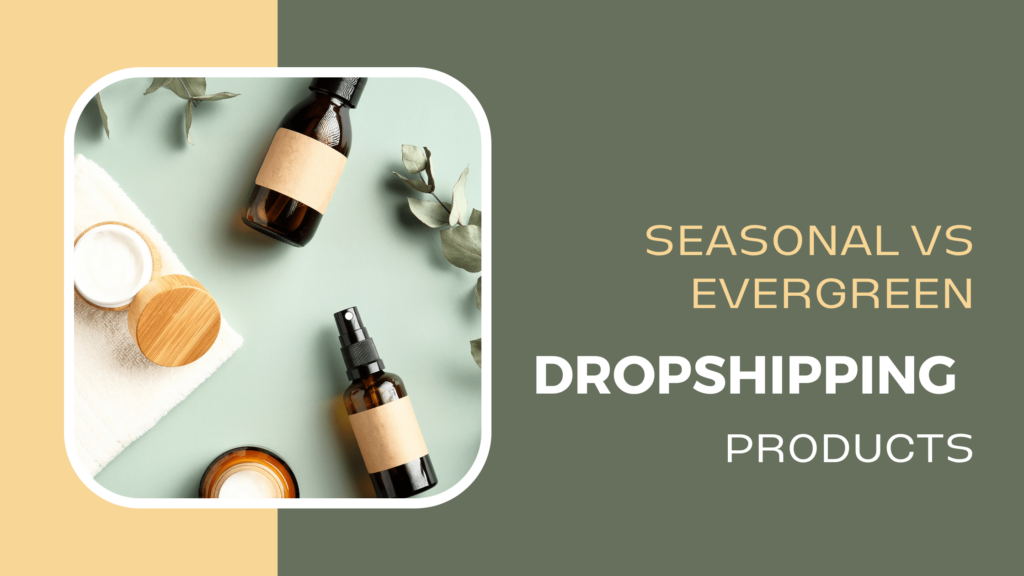Seasonal vs Evergreen Dropshipping Products — Which is Better?
Dropshipping success depends on smart product selection. Two main approaches are seasonal dropshipping and evergreen dropshipping niches. Seasonal products see high demand during specific times, like holiday gifts or summer gear. Evergreen products sell consistently year-round, offering steady income.
Choosing the right strategy depends on business goals, trends, and risk tolerance. A mix of both can help balance profits and sustainability. Understanding the strengths of each approach will help sellers make informed decisions.
Understanding Seasonal Dropshipping
Seasonal dropshipping products are items that see a surge in demand during specific times of the year. These products sell fast but have limited appeal outside their peak seasons.
Examples of Seasonal Dropshipping Products:
- Holiday Items – Christmas decorations, Halloween costumes, Easter gifts.
- Summer Essentials – Pool accessories, beachwear, travel gear.
- Winter Gear – Heated blankets, snow gear, holiday-themed products.
- Back-to-School Supplies – Stationery, backpacks, and tech gadgets.
Seasonal dropshipping can bring quick profits if timed right. However, sellers must plan inventory and marketing carefully to avoid stock issues or missed opportunities.
Pros and Cons of Seasonal Dropshipping
Seasonal dropshipping can bring big profits, but it also comes with risks. Below is a detailed comparison of the pros and cons to help you decide if it’s the right approach for your business.
| Factor | Pros | Cons |
| High Demand | Products sell fast during peak seasons, leading to quick profits. | Sales drop drastically after the season ends. |
| Profit Potential | High markups are possible due to urgency and limited availability. | Price wars may happen as competitors try to undercut each other. |
| Marketing Impact | Seasonal trends create strong marketing opportunities. | Requires constant rebranding and new ad campaigns. |
| Inventory Risk | No need to stock up—sell while demand is high. | Leftover inventory can become unsellable after the season. |
| Flexibility | Ability to switch products each season to match trends. | Requires ongoing research to predict trends correctly. |
| Customer Interest | Customers actively search for seasonal items. | Hard to build a loyal customer base for long-term growth. |
| Ad Spend ROI | Higher conversion rates during peak season. | Can be expensive to advertise due to high competition. |
| Scalability | Easy to scale quickly during peak demand. | Growth is limited to certain times of the year. |
Understanding Evergreen Dropshipping
Evergreen dropshipping products are items that stay in demand all year. Unlike seasonal dropshipping products, they don’t rely on trends or specific times of the year to sell well. These products offer steady revenue and a reliable business model.
Key Characteristics
- Consistent Demand – People need them regardless of the season.
- Wide Audience – They appeal to a broad customer base.
- Less Risky – No drastic sales drops like seasonal items.
Examples of Evergreen Dropshipping Niches:
- Fitness Gear – Resistance bands, yoga mats, and water bottles.
- Pet Supplies – Beds, toys, grooming tools, and food bowls.
- Home Essentials – Kitchen gadgets, storage solutions, and cleaning products.
- Tech Accessories – Phone cases, chargers, and headphones.
- Self-Care Items – Skincare products, hair tools, and supplements.
Selling evergreen products ensures a stable business without relying on seasonal spikes.
Pros and Cons of Evergreen Dropshipping
Evergreen dropshipping products sell consistently throughout the year. They are not tied to seasons, holidays, or trends, making them a reliable choice for long-term success. Below is a detailed comparison of the advantages and challenges of selling in evergreen dropshipping niches.
| Pros | Cons |
| Steady Demand – Products sell year-round, ensuring a stable income. | High Competition – Many sellers target these products, making it harder to stand out. |
| Long-Term Growth – Consistent sales help build a sustainable business. | Slower Sales Growth – No sudden demand spikes like seasonal products. |
| Easier Inventory Management – No need to worry about stock running out due to seasonal shifts. | Potential Market Saturation – Many evergreen products have strong competition. |
| Less Marketing Pressure – No urgency to push sales before a season ends. | Requires Brand Differentiation – Need strong branding or unique angles to compete. |
| Predictable Revenue – Easier to forecast earnings and plan business strategies. | Price Wars Possible – Many sellers compete on price, reducing profit margins. |
| SEO Benefits – Content marketing and SEO efforts bring long-term traffic. | Less Room for Trend-Based Marketing – Can’t leverage seasonal hype for quick wins. |
Selling in evergreen dropshipping niches is a great way to build a stable, long-lasting business. However, competition can be tough, and scaling requires strong branding and marketing. Businesses should weigh these factors before deciding on their product strategy.
Comparing Seasonal vs Evergreen Dropshipping
| Factor | Seasonal Dropshipping | Evergreen Dropshipping |
| Profitability & Revenue Potential | Brings quick revenue spikes during peak seasons. | Provides consistent income throughout the year. |
| Sales drop significantly in the off-season. | Steady demand ensures long-term profitability. | |
| Marketing & Advertising Strategies | Requires aggressive, time-sensitive campaigns. | Focuses on long-term SEO and content marketing. |
| High competition during peak times increases ad costs. | Lower ad costs due to steady demand. | |
| Email lists and remarketing need seasonal adjustments. | Can build lasting customer relationships over time. | |
| Inventory & Supplier Management | Requires careful timing to avoid overstock or stockouts. | Needs strong supplier partnerships for reliable fulfillment. |
| Suppliers may have limited stock outside peak season. | Easier to maintain stable inventory levels. | |
| Must predict demand accurately to avoid dead stock. | Less risk of unsold inventory going to waste. | |
| Scalability & Business Sustainability | Requires frequent product changes and trend adaptation. | Easier to scale without major product shifts. |
| Higher risk as demand fluctuates unpredictably. | Lower risk with steady consumer interest. | |
| Can be profitable but needs constant reinvention. | Allows for automation and long-term growth. |
Finding the Right Balance
Balancing evergreen dropshipping niches with seasonal dropshipping can maximize profits and keep your store relevant year-round. A hybrid approach offers stability while allowing flexibility to capitalize on trends.
Why a Hybrid Approach Works Best
Evergreen products provide consistency
- Selling evergreen items ensures steady sales throughout the year.
- These products keep your store active, reducing the risk of revenue drops.
Seasonal trends bring extra revenue
- Adding seasonal products creates urgency and attracts buyers.
- Limited-time offers encourage impulse purchases.
Flexibility to adapt to demand
- A mix of both allows businesses to adjust based on customer interest.
- You can test seasonal trends while maintaining a solid revenue base.
Examples of a Balanced Strategy
Fitness & Wellness Store
- Sells workout gear, supplements, and equipment year-round (evergreen).
- Promotes holiday sales on gift bundles or summer workout gear (seasonal).
Home Decor Store
- Offers furniture and decor that customers buy anytime (evergreen).
- Introduces seasonal collections for holidays or trends (seasonal).
Tech & Gadgets Store
- Features popular accessories like phone cases and chargers (evergreen).
- Adds limited-edition holiday gadgets or back-to-school deals (seasonal).
By combining evergreen dropshipping niches with seasonal dropshipping, businesses can maintain stability while taking advantage of short-term trends. This approach keeps inventory fresh, attracts different customer segments, and maximizes revenue potential.
Tips for Choosing the Right Products
Research Market Demand and Competition
- Study trends to see which products are in demand year-round and which peak during specific seasons.
- Use tools like Google Trends, social media insights, and marketplace data to track interest levels.
- Check competitor listings to understand pricing, product variety, and customer preferences.
Test New Seasonal Products While Maintaining a Strong Evergreen Lineup
- Keep a solid foundation of evergreen dropshipping niches that generate consistent sales.
- Experiment with trending seasonal products to attract new customers and boost revenue.
- Start with small stock volumes for seasonal items to test demand before scaling up.
Use Data and Analytics to Optimize Product Offerings
- Monitor sales data to identify high-performing products and spot emerging trends.
- Track conversion rates, profit margins, and customer feedback to refine your product selection.
- Adjust pricing and marketing strategies based on real-time performance insights.
A well-balanced strategy helps maximize revenue while keeping risks low. By carefully selecting seasonal dropshipping products and combining them with reliable evergreen items, businesses can create a sustainable and profitable dropshipping model.
Final Thoughts
Both seasonal and evergreen products have their pros and cons. Seasonal dropshipping can bring quick profits, while evergreen dropshipping niches offer a steady income. Testing different strategies helps find what works best.
Mix both product types to stay profitable year-round. Plan ahead for seasonal trends and keep evergreen products for stability. Stay flexible and adjust based on demand. A smart balance between seasonal and evergreen items can help build a sustainable dropshipping business.



